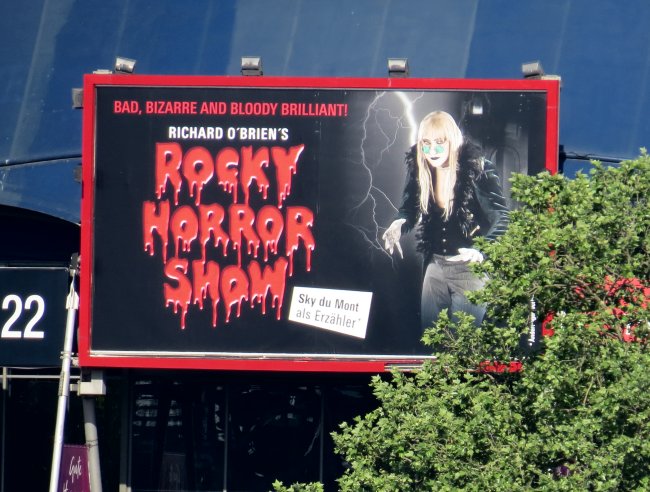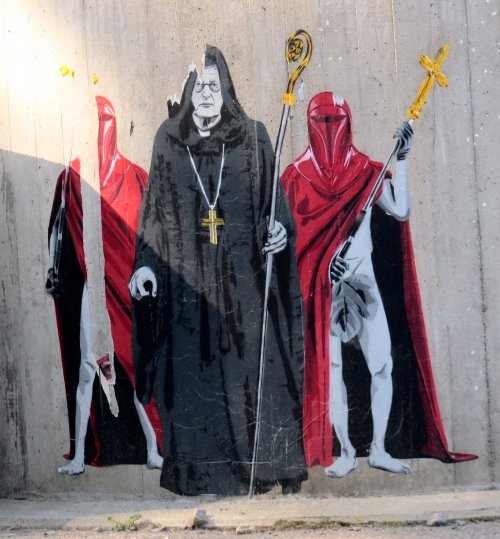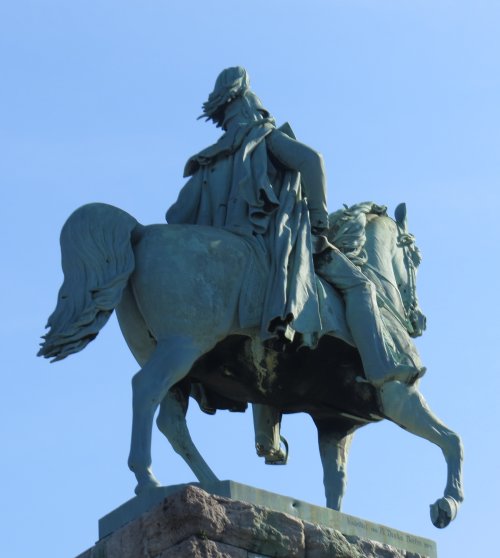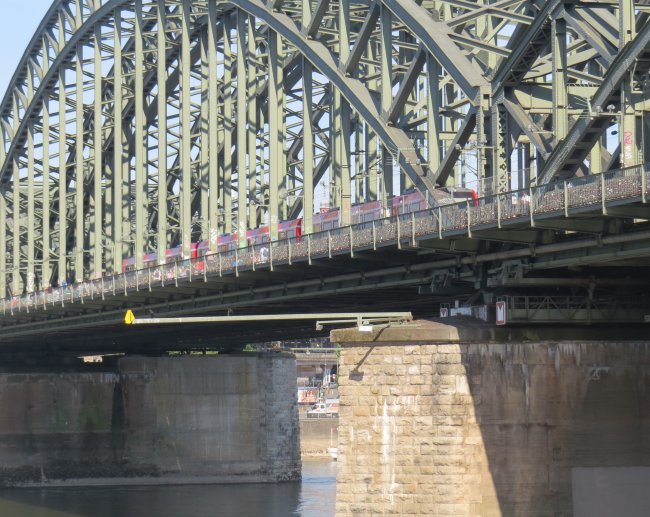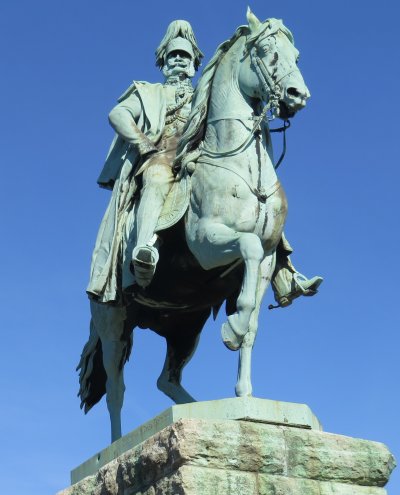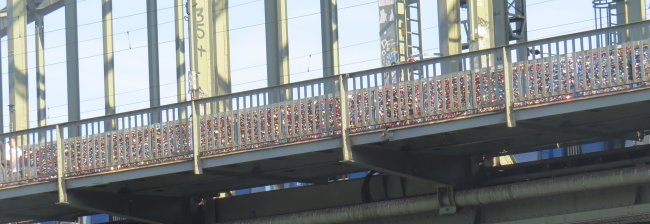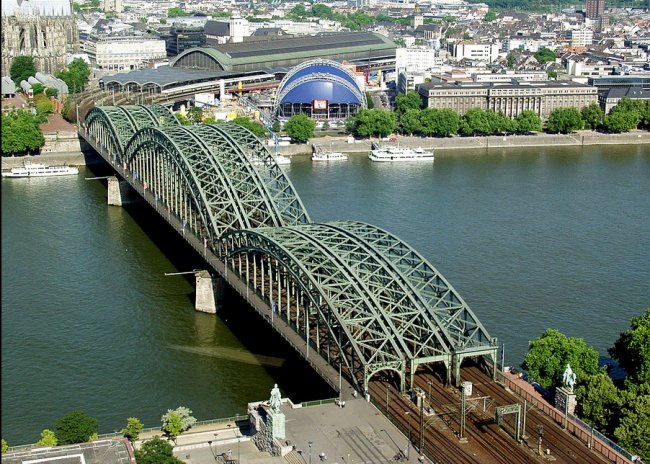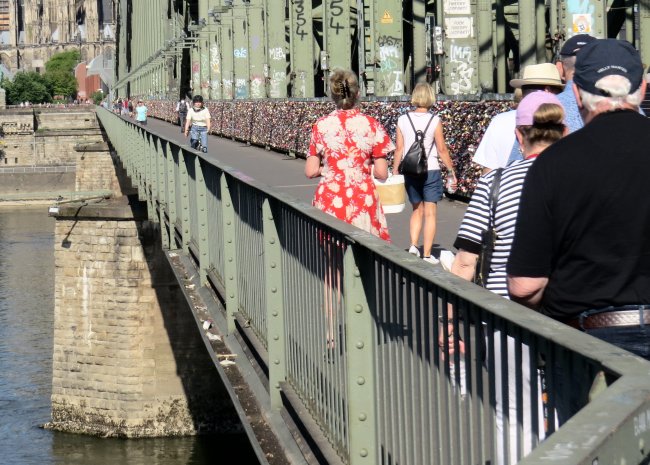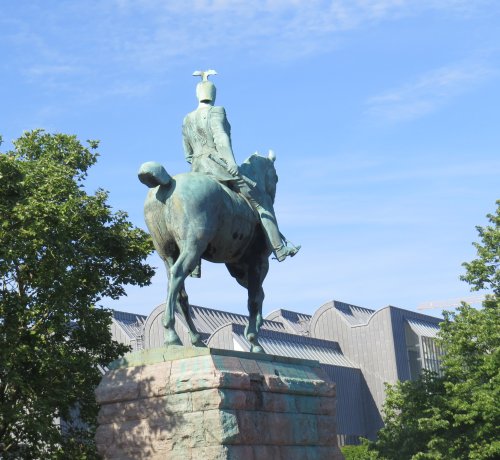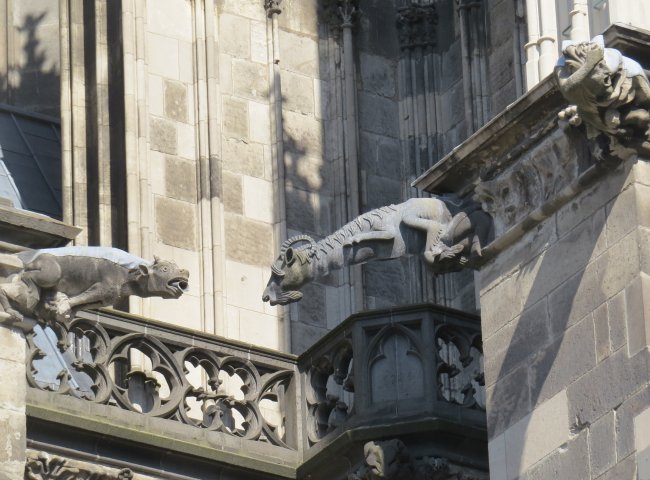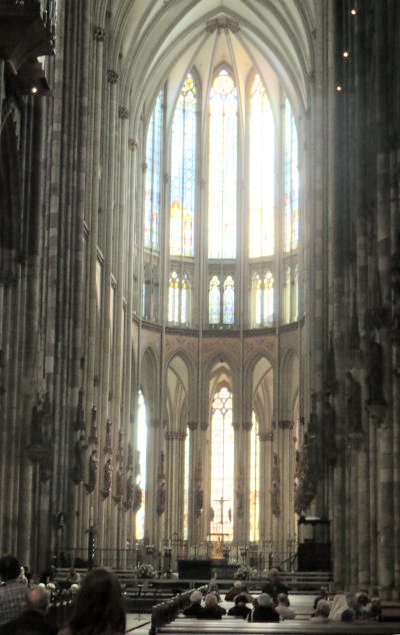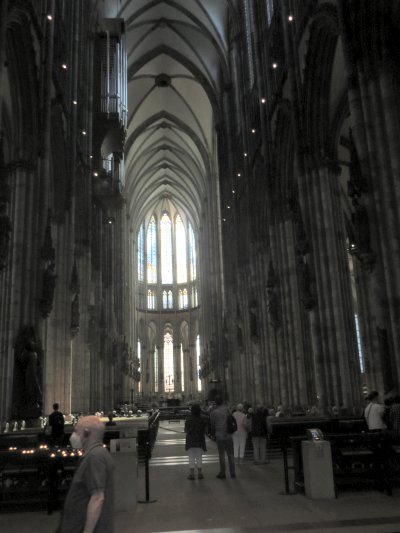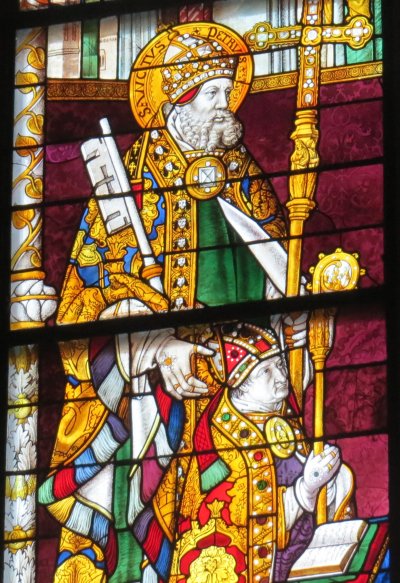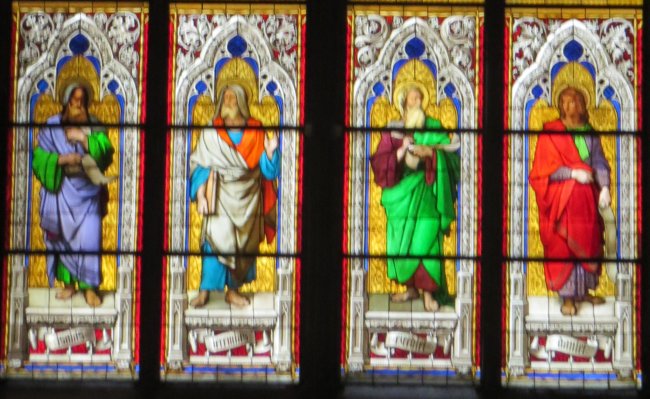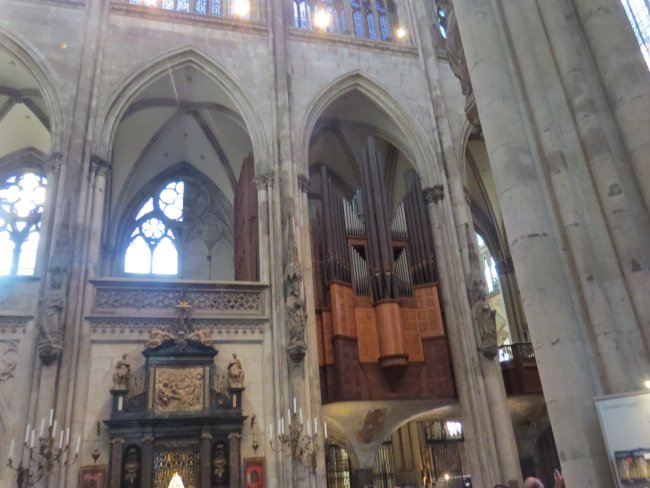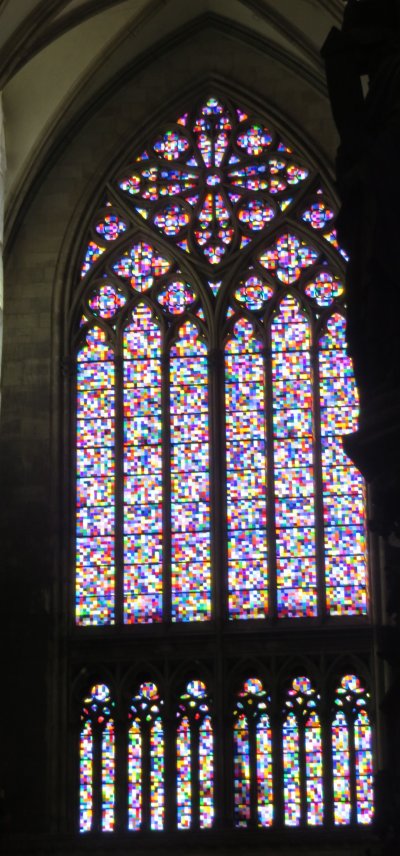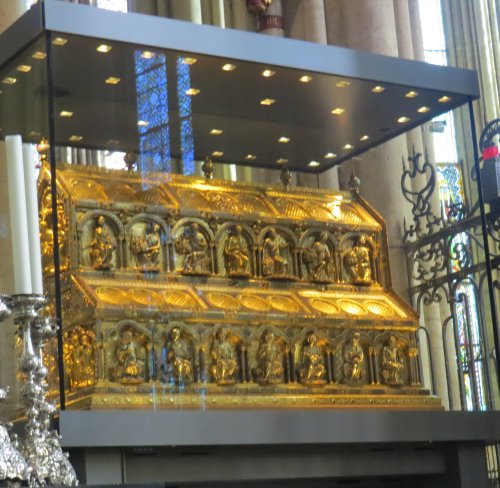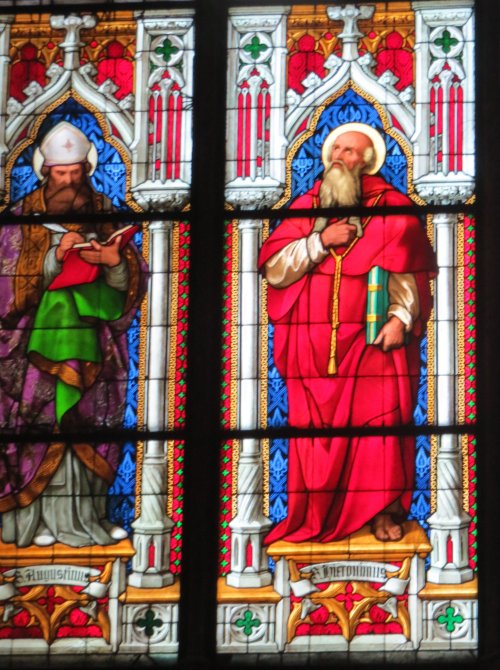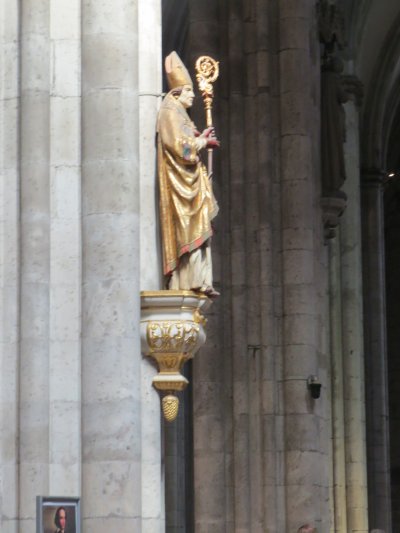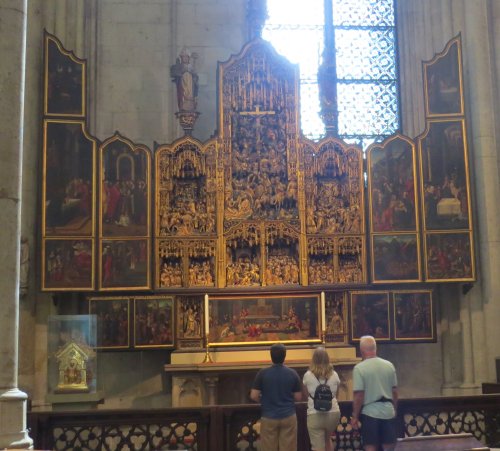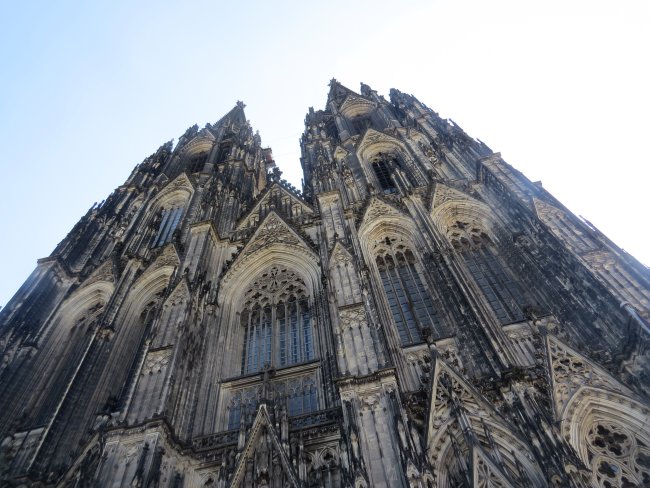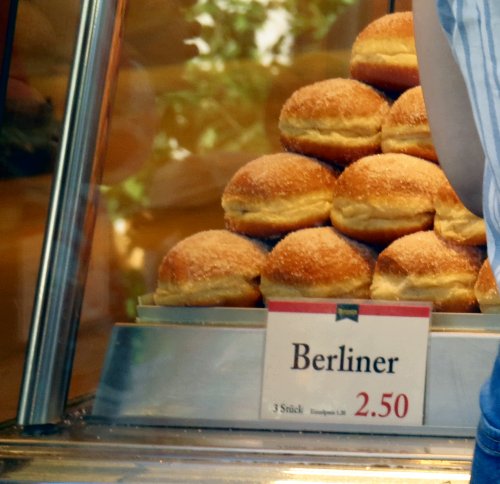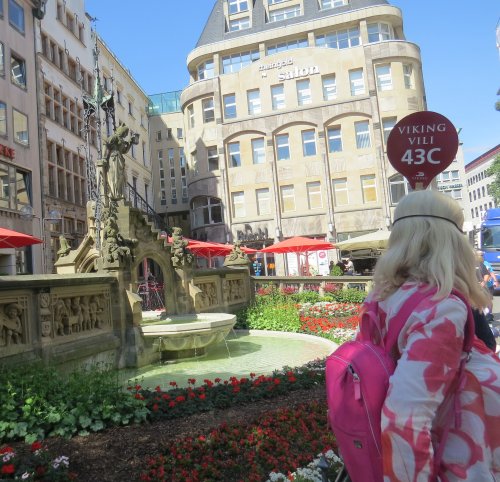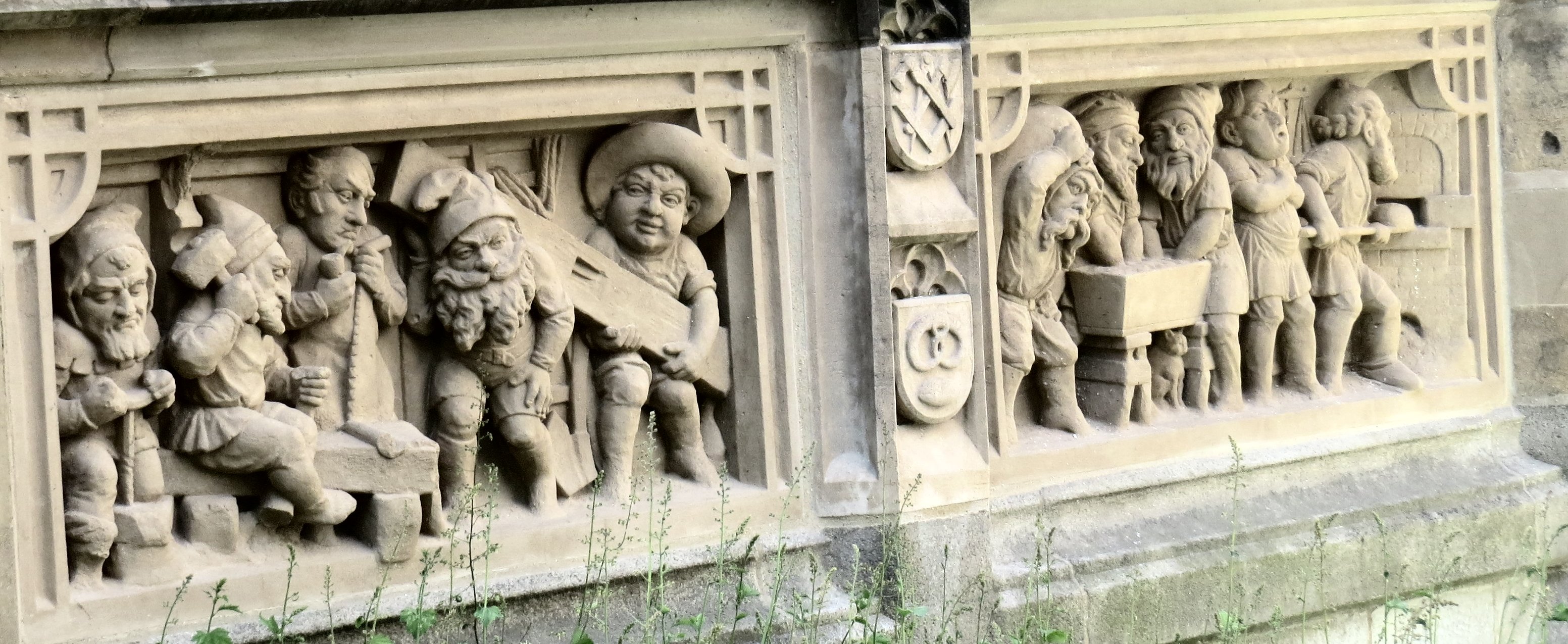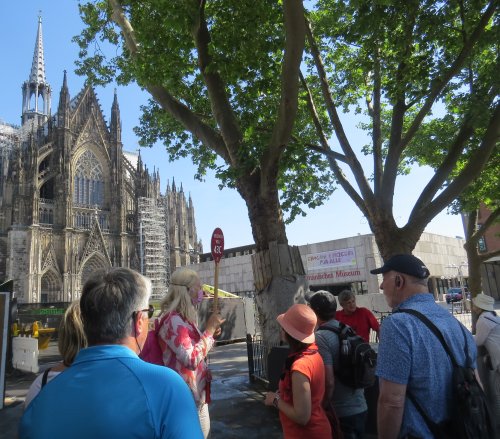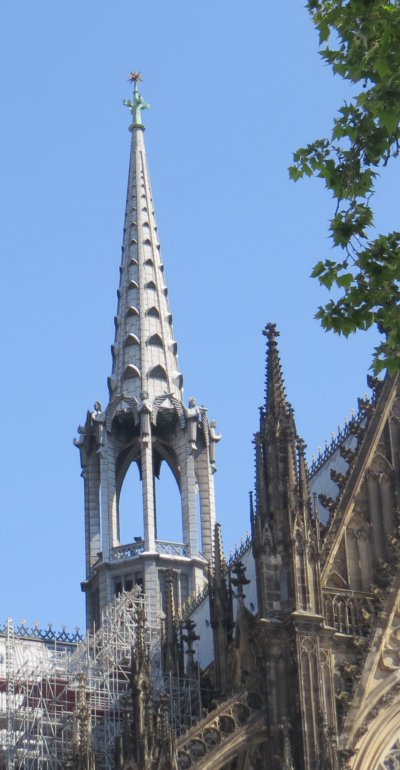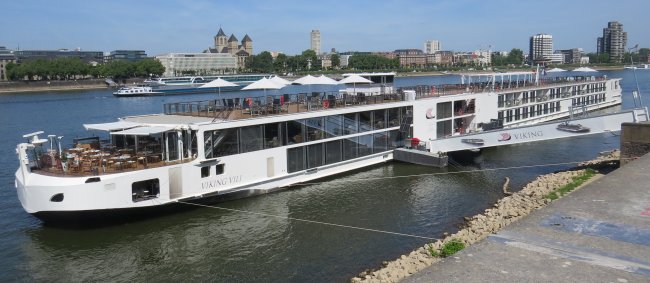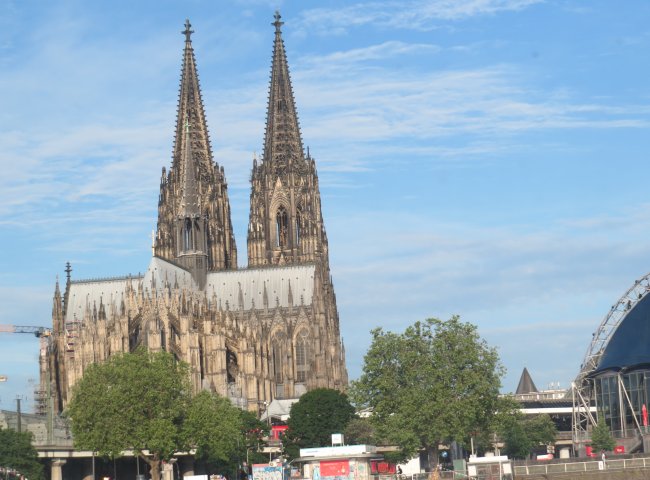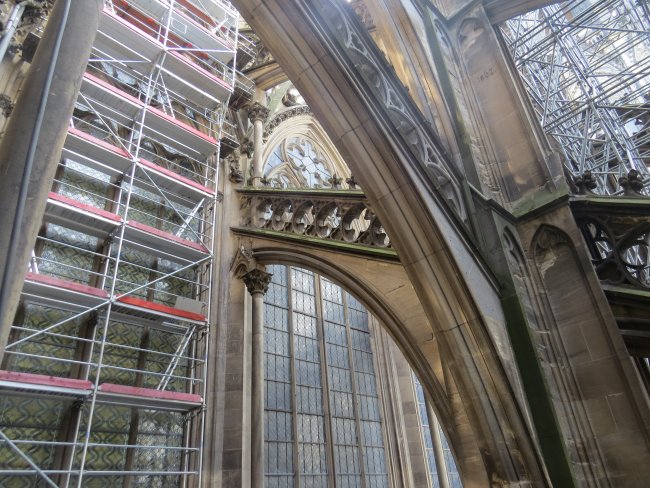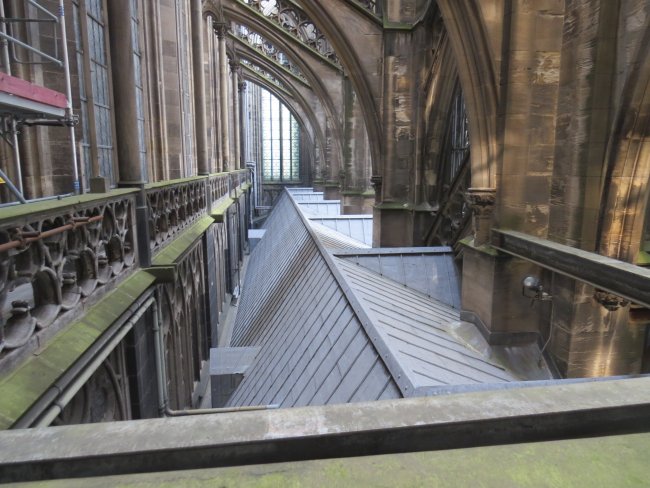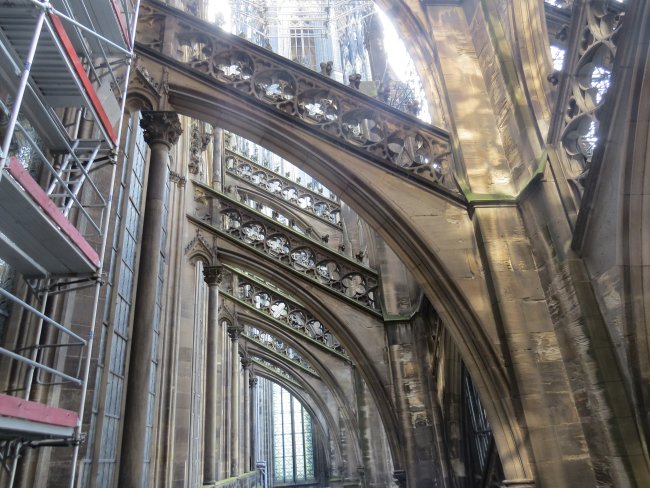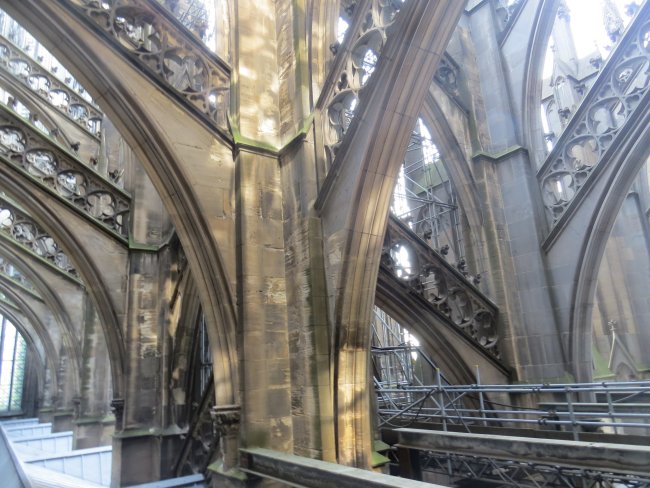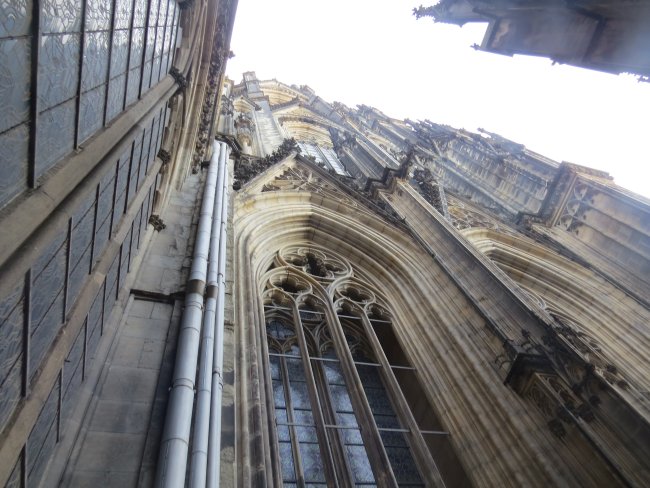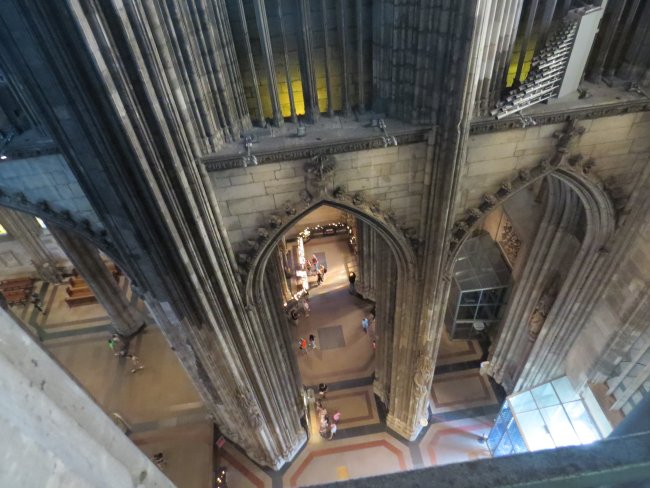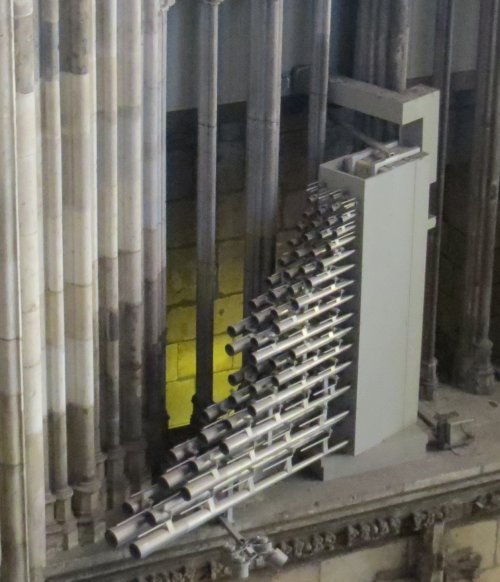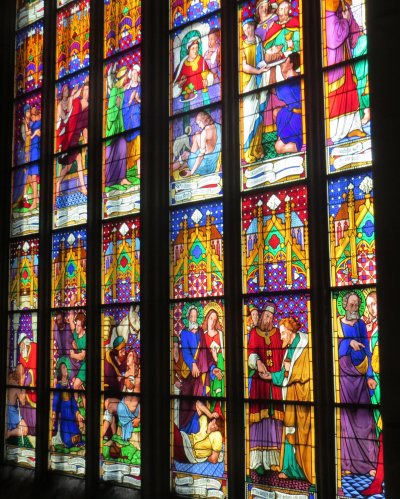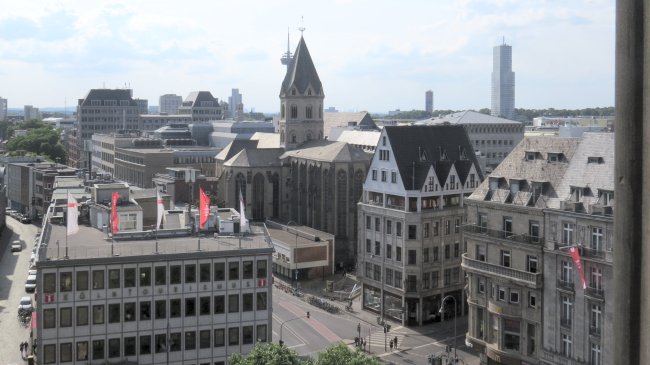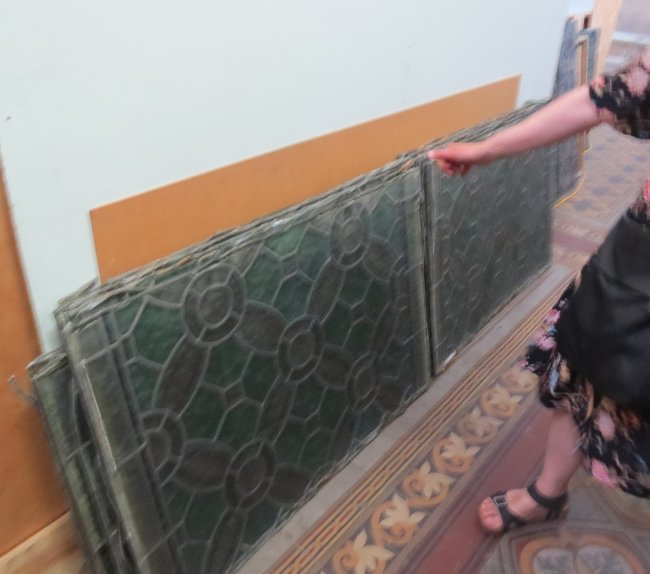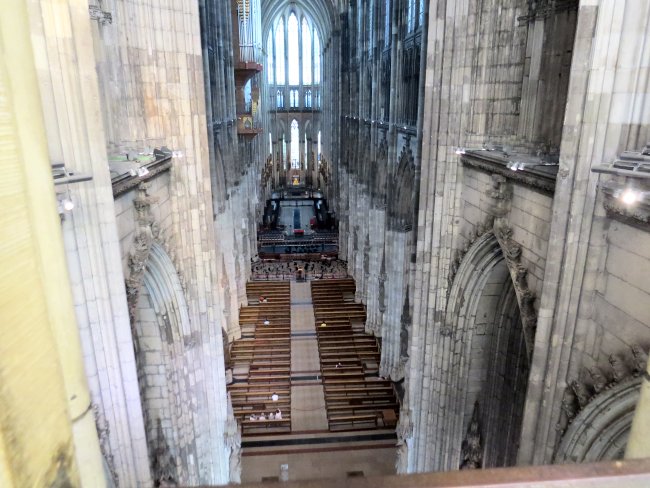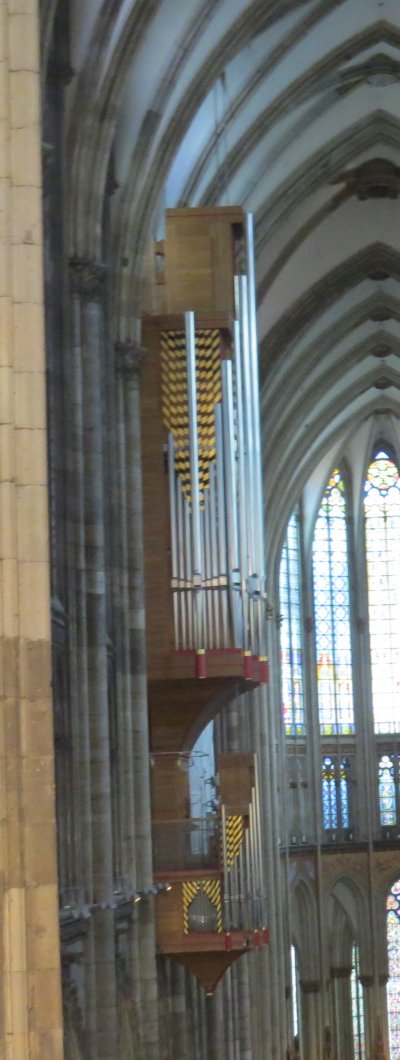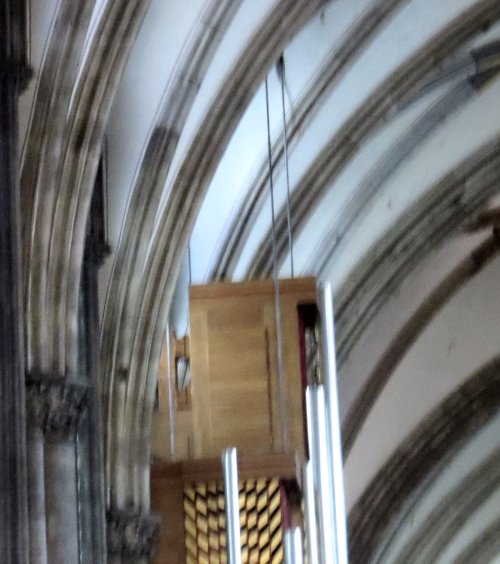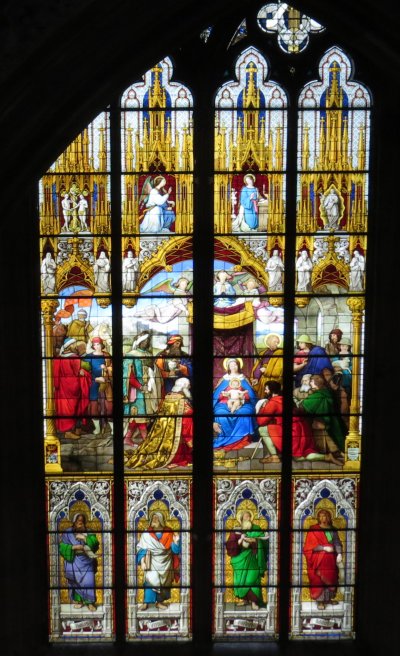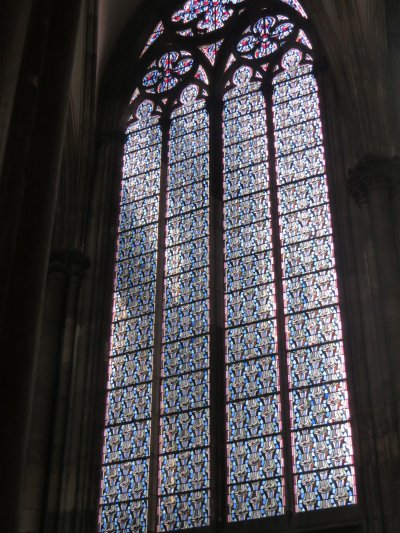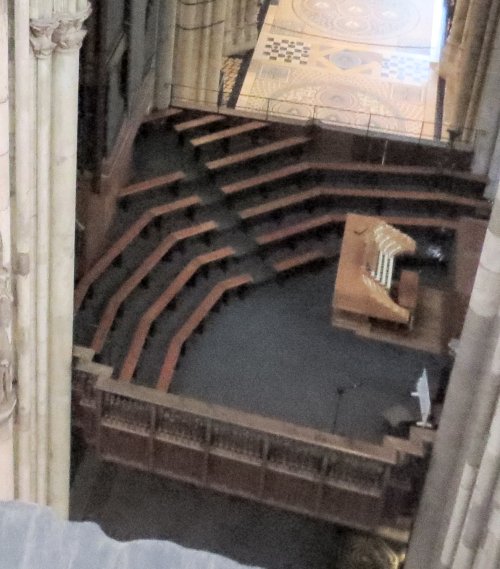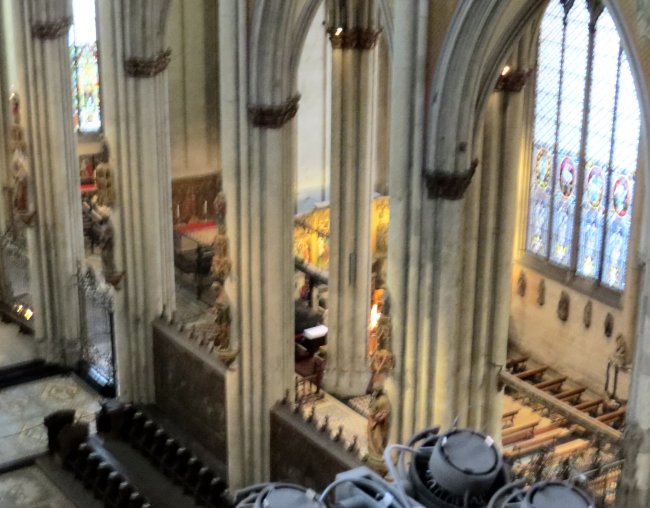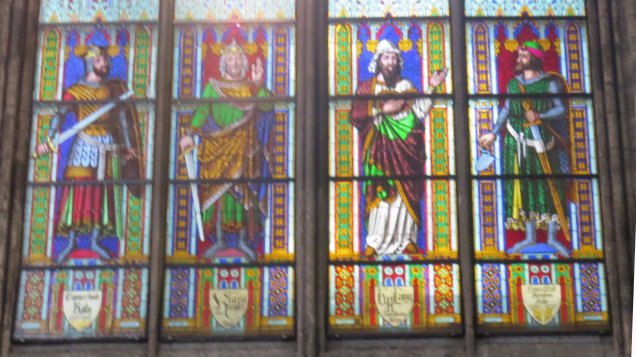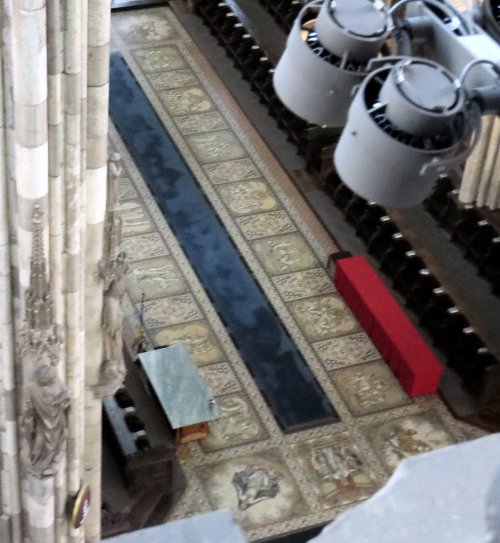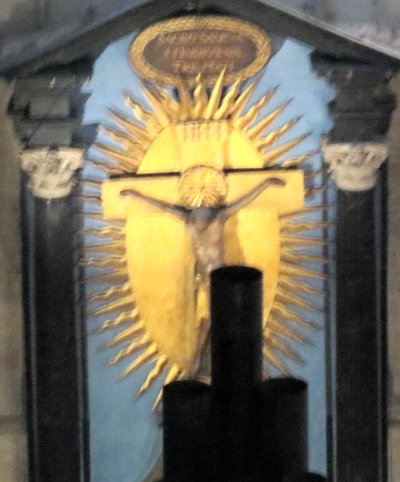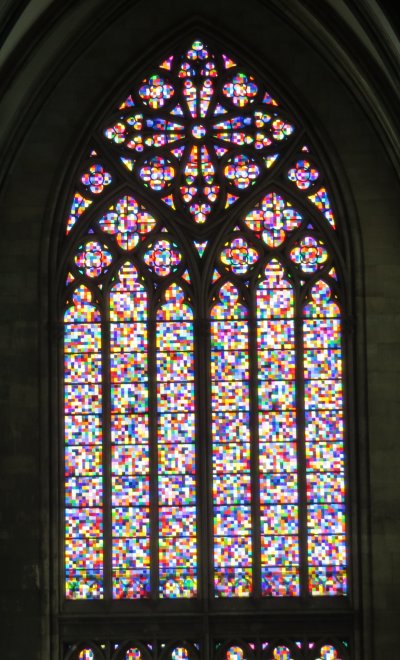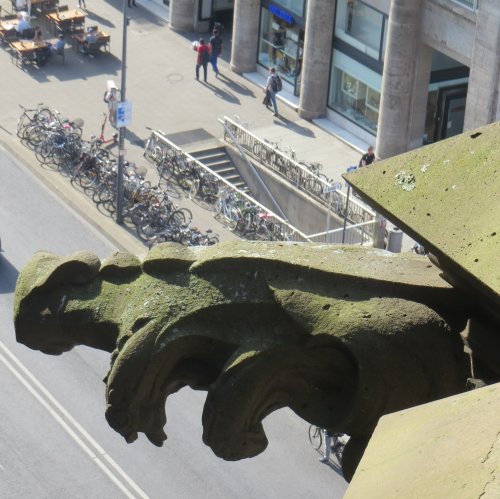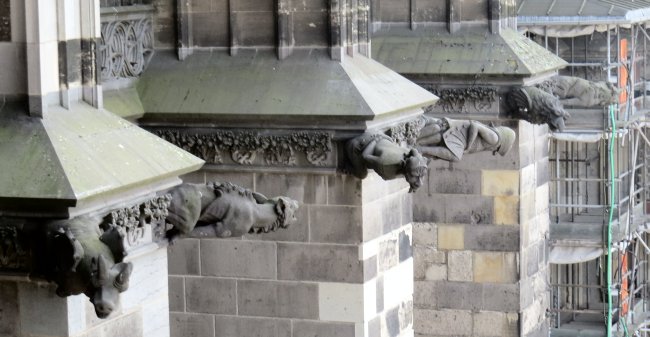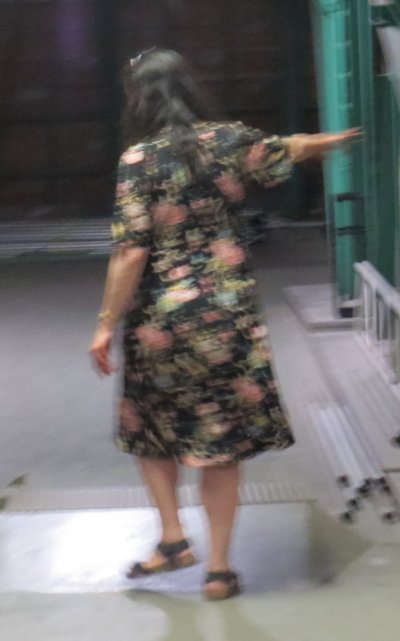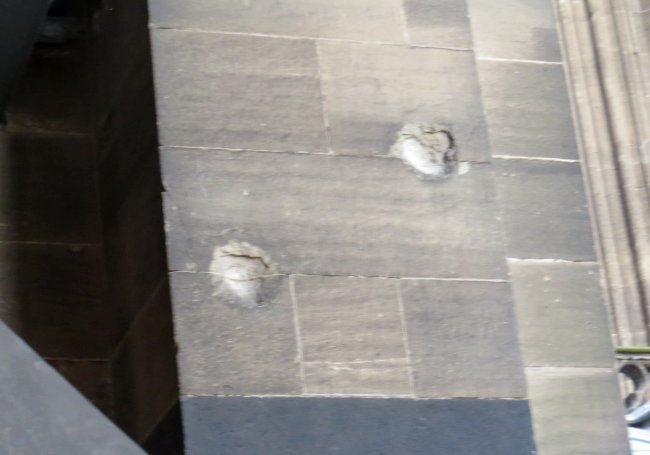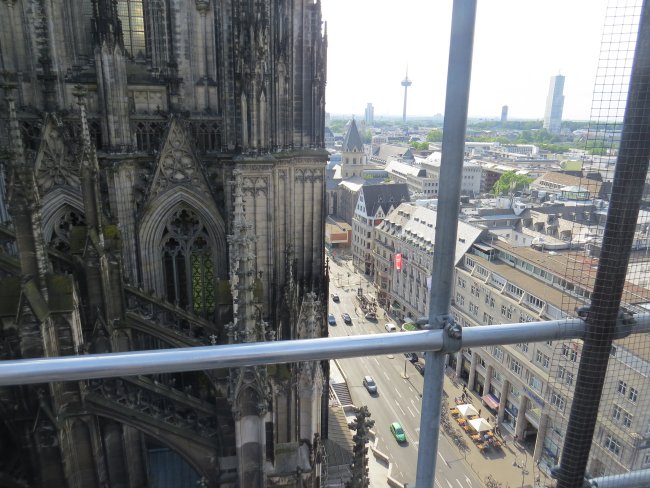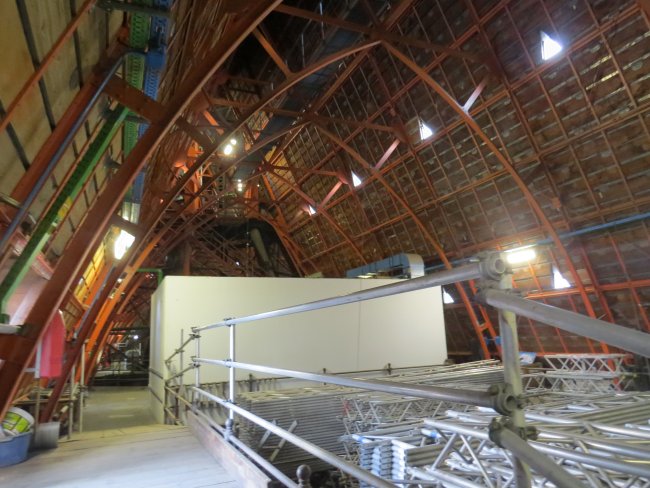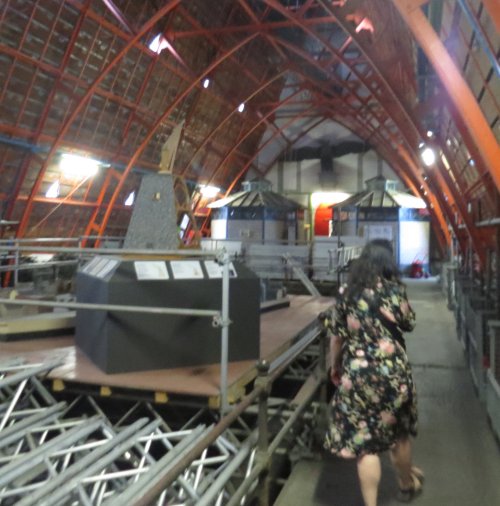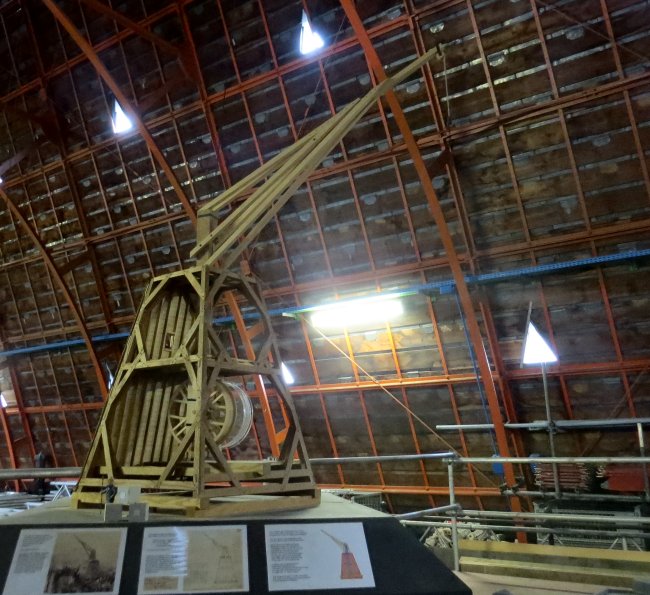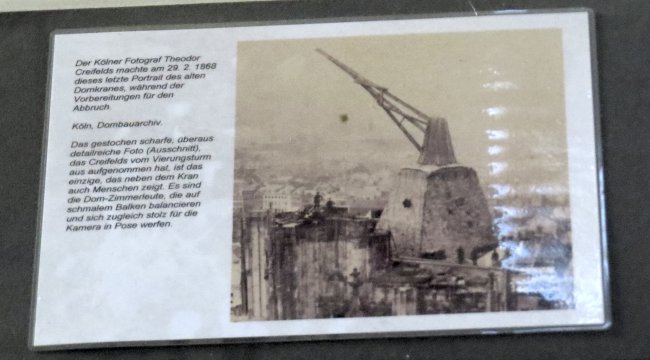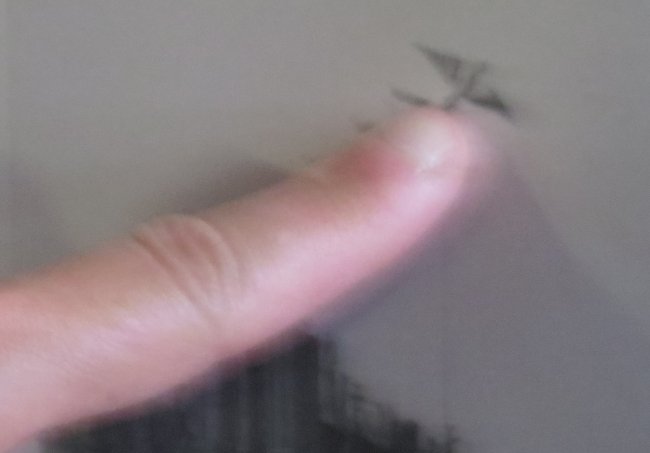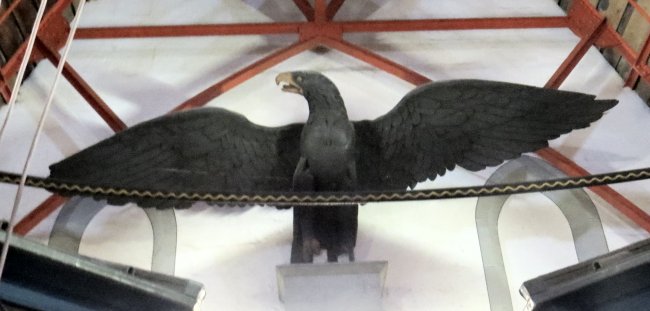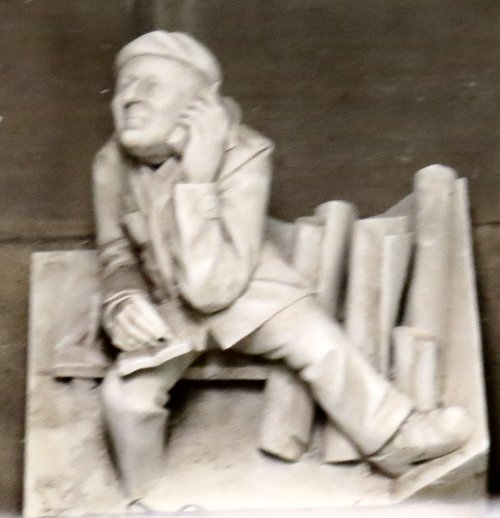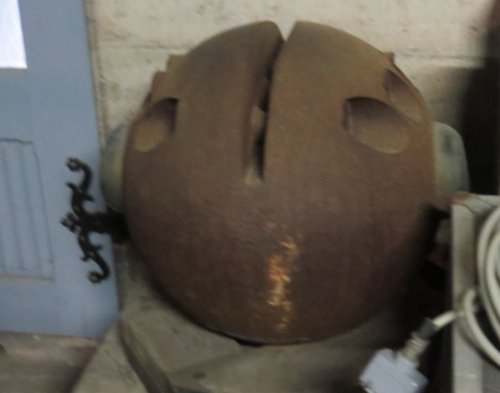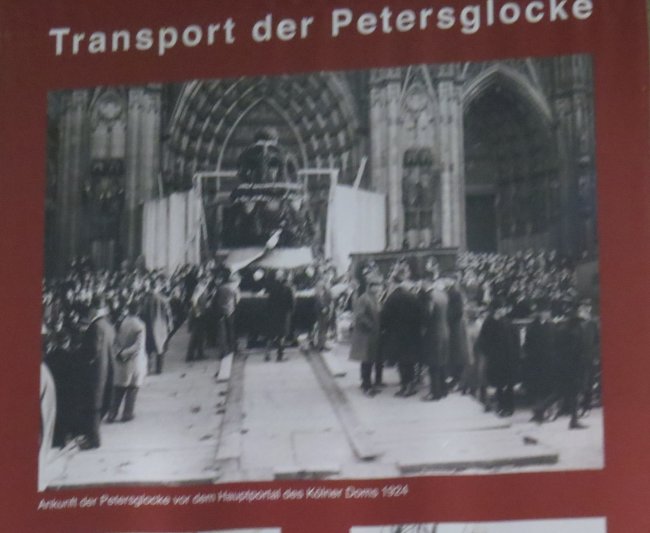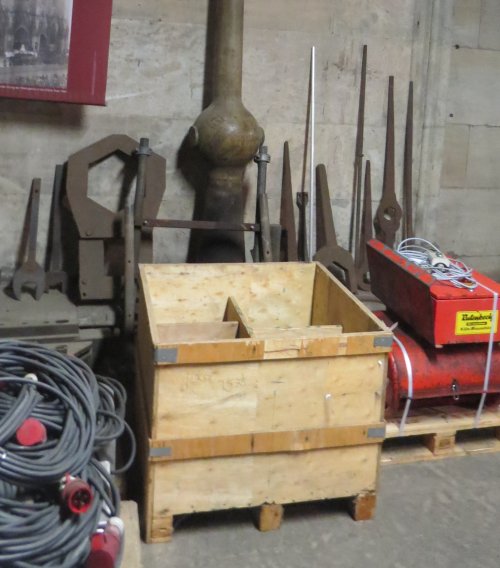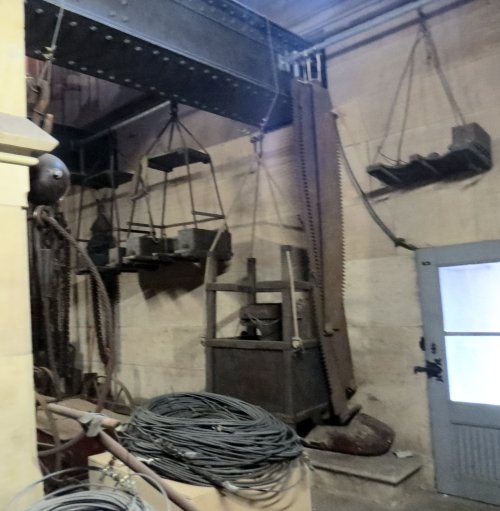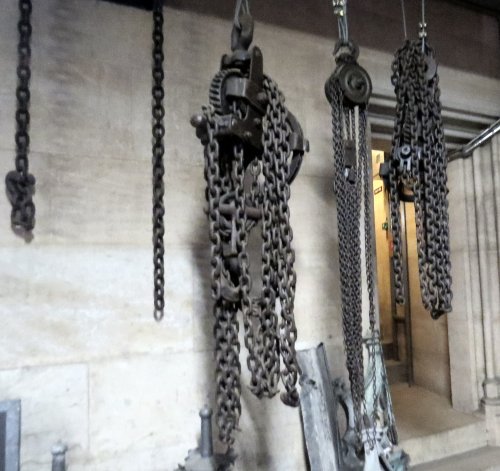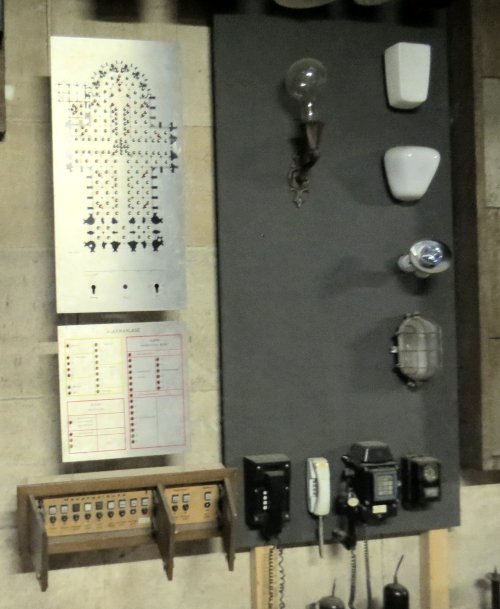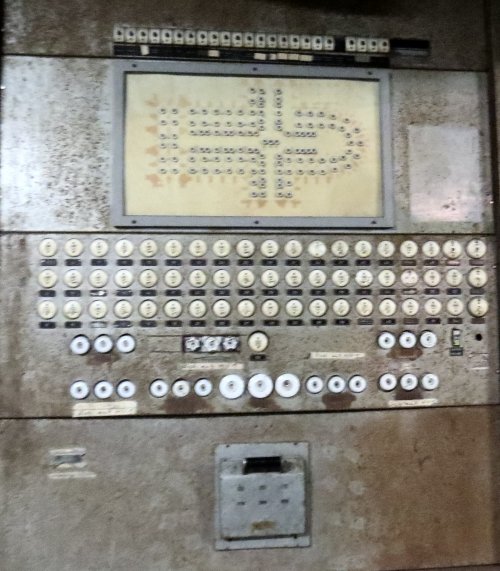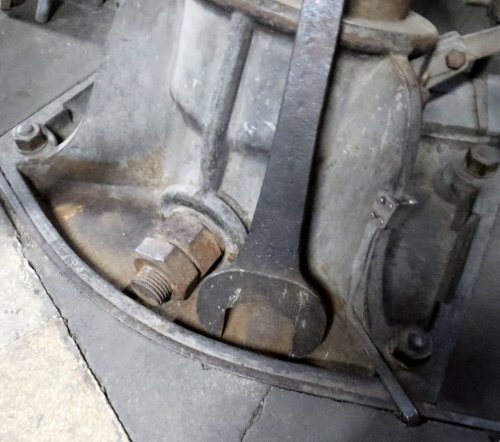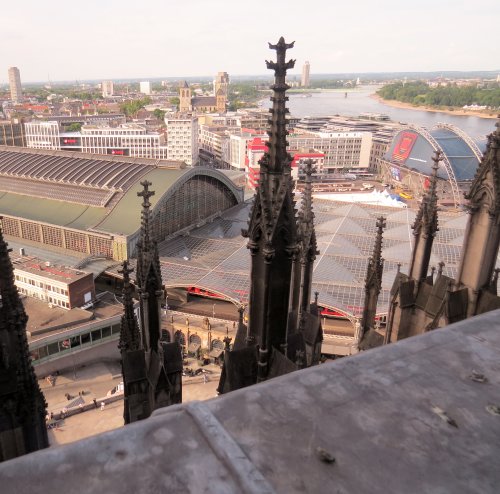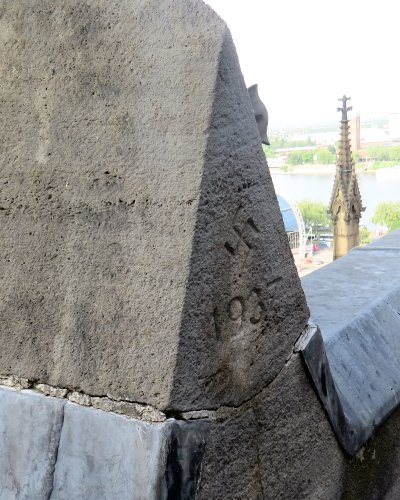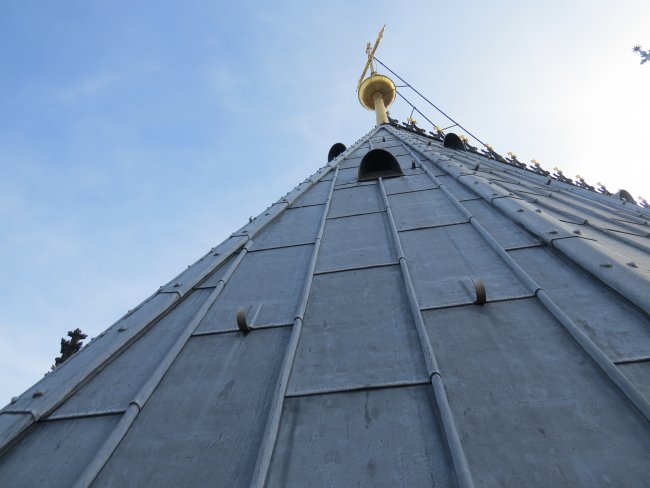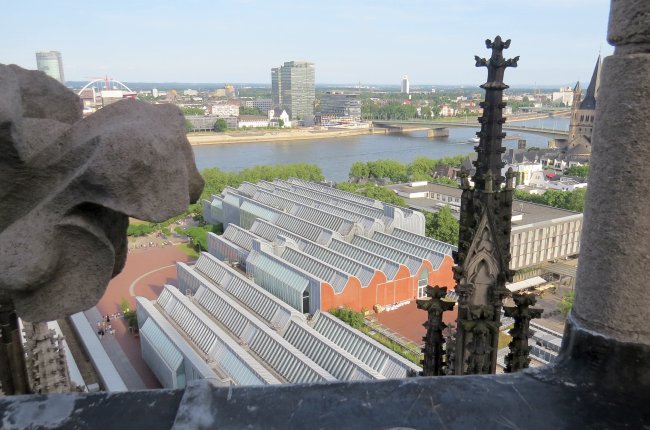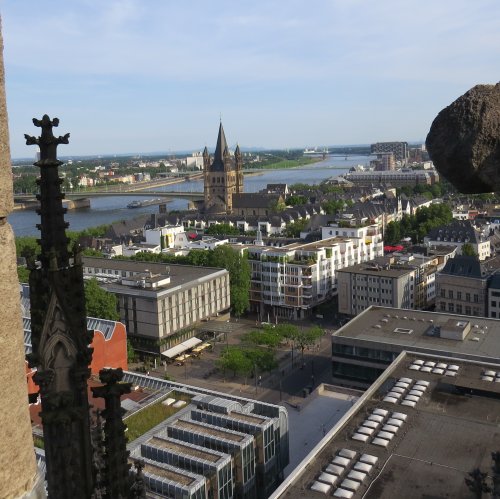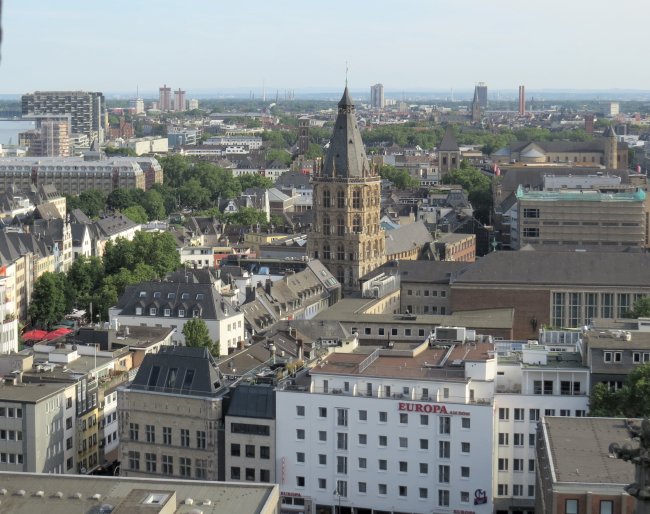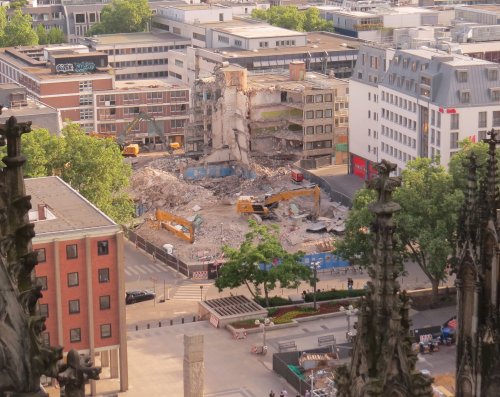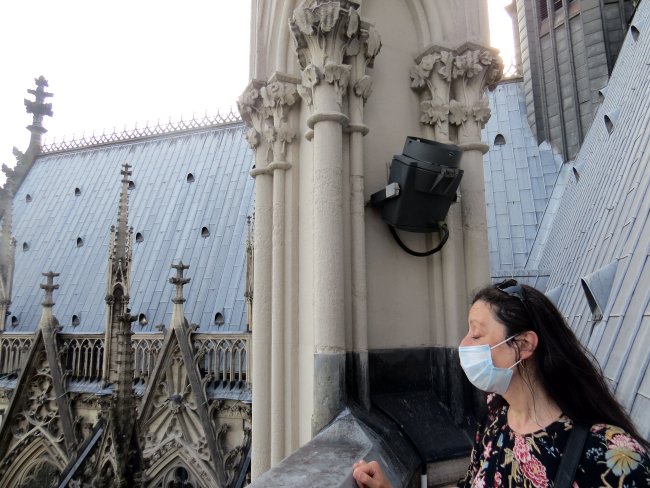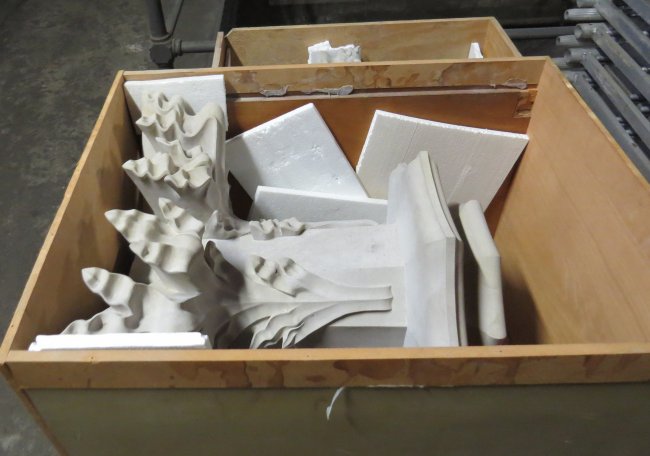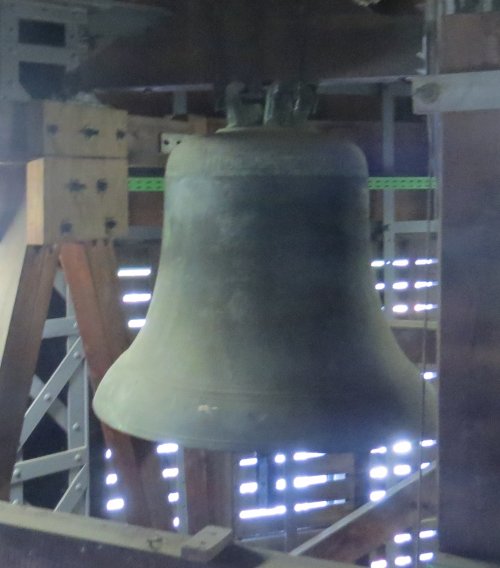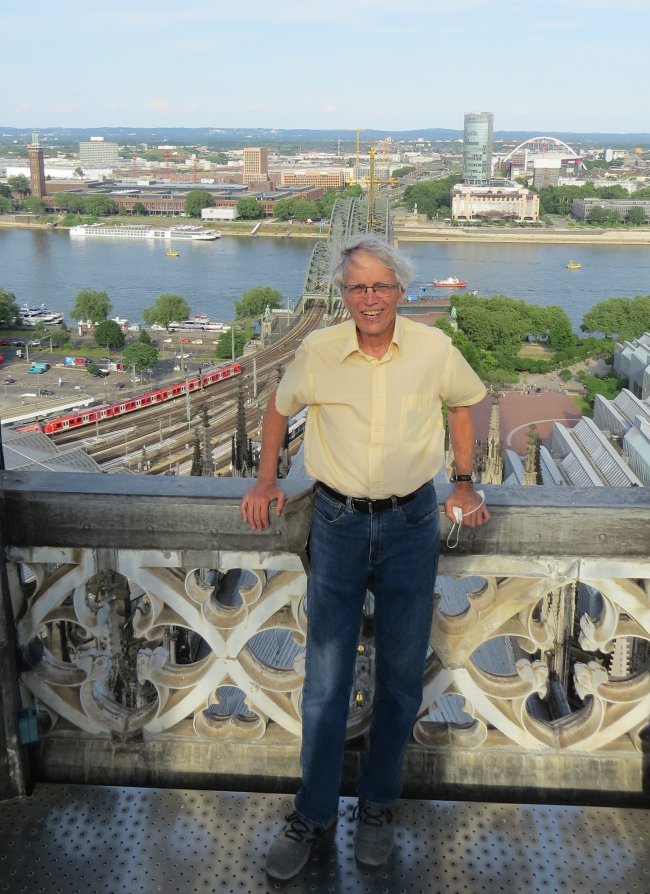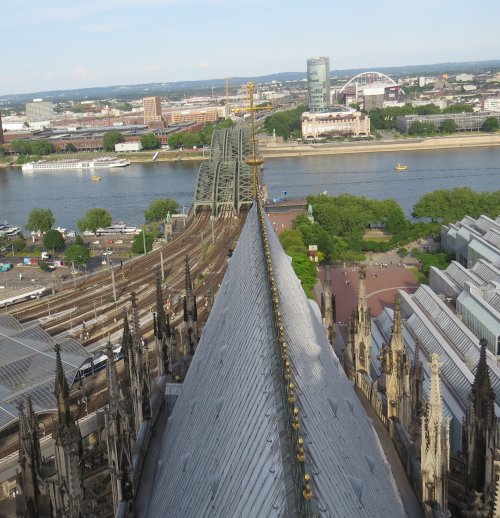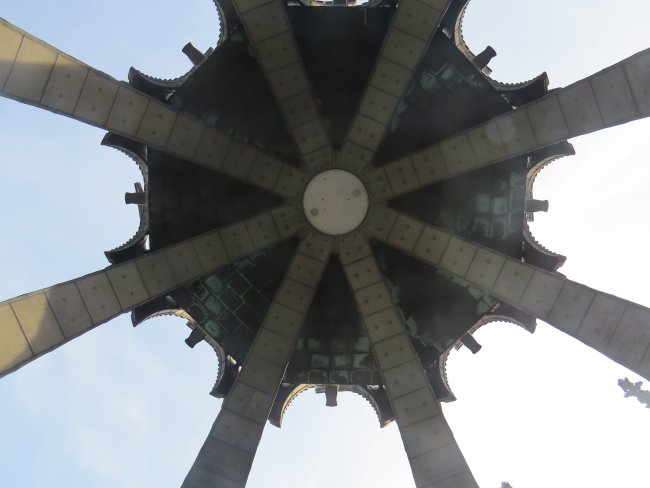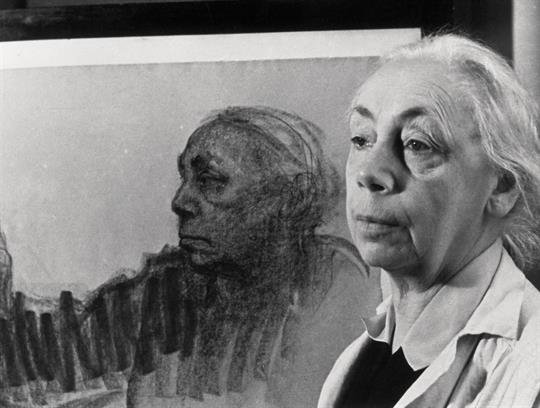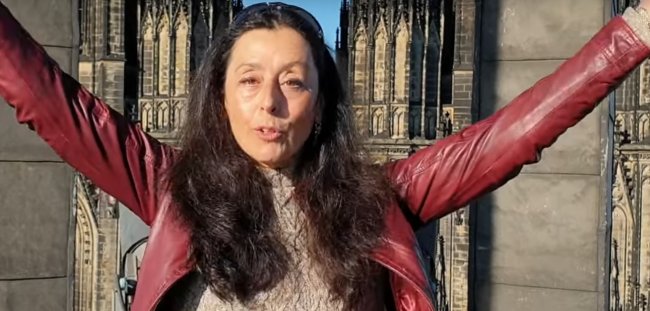Before the morning excursion: I woke up a little after 1 a.m. with an idea. I remembered Denise Flavan's remark at dinner that it might still be somewhere on the computer. I had dismissed the notion because I had looked in all of the files that I had touched. Two things occurred to me. The first was that I could search the whole hard drive for the name of a file that I knew should be there. IMG_9999.jpg and IMG_0001 came to mind. The second was to check the "Recycle" folder on my laptop. It had been years since I accidentally deleted a file, but I still remembered how to open the Recycle folder.
I started up my laptop and opened the Recycle folder from the Start screen. I sorted it by decreasing date, and—sure enough—all of the missing files appeared. In a couple of minutes I had successfully moved them to the folder for Day 12.
Denise had been right all along. I was just too arrogant to acknowledge the value of her suggestion.
I read a chapter from Spoonbenders and then fell back to sleep.
When I woke up in the morning I sent Sue an email that I had found all of the lost photos. Then I turned in my Covid tube and went to a breakfast that resembled in most particulars all of the previous ones. I was pretty excited about the prospect of seeing the Cologne Cathedral, which was definitely an architectural wonder, both as part of the walking tour and later from on high in the Top of Cologne tour.
At about 9 a.m. the ship arrived in Cologne, which is spelled Köln. The pronunciation was somewhere between kun and coon. The "l" seemed to have little or no effect on the sound. The Viking Vili's berth was on the west bank, very near the incredibly busy Hohenzollern Bridge. It took the crew a few minutes to install the ramp from the second deck up to the shore. Then the walking excursion began.
The walking tour of Cologne: I was poorly prepared for the walking tour. I should have done more research about the interior of the cathedral and what else was nearby. I had read the material on Rick Steves' website, but it was not of much help.
The three photos shown above were taken on the west bank of the river before we crossed the bridge. Gary Nicholson informed us that Viking formerly had provided buses to transport passengers to the cathedral across the river, but the city no longer allowed the buses to park where they previously did. Since the newly designated space would require a longer walk than one from the ship, we now were required to cross the bridge on foot.
We climbed the steep ramp and assembled on the west bank. The guide for my group (43C), was a woman named Ulrike.[1] After synchronizing our QuietVoxes we walked together from the ship to the bridge. It contained six tracks, three in each direction, as well as wide pedestrian/bike areas on both sides. It also was home to an ungodly number of padlocks[2] that young couples had permanently attached to the chain-link fences designed to keep people from falling onto the tracks. The keys to these lock were in the murky depths of the Rhine.
The Hohenzollern Bridge is the most heavily used railway bridge in Germany. It connected two large stations on both sides of the river. In 2022 over 1,200 trains passed over it daily. Plans were underway to divert some of that traffic away from the central city.
The bridge was about a quarter mile in length. So, it took us five minutes or so to walk across it. No cars were allowed on the bridge, but there were plenty of bicycles. It occurred to me that this walk might have been prohibitively difficult for Sue, especially in the heat. I doubt that she would have tried it. On the other hand, it would have been really tough for her just to sit on the ship with this fantastic city in view.
We always used the passageway on the north side of the bridge. The very busy train station was located just southeast of the bridge. The traffic around it would have made walking in a group quite difficult.
During the short walk across the plaza between the bridge and the church Ulrike told us about the Ludwig Museum of modern art that was on our left. I cannot say that I paid much attention. We soon approached the unforgettable entrance to the cathedral.
The exterior of the cathedral was as impressive as any that I have ever seen. Construction began in 1248, and was not completed until 632 years later. It suffered significant damage during World War II, but everything in its vicinity had been completely leveled. Because the church could be seen from a great distance the allied war planners used the church as a visual reference point.
About ninety permanent employees maintained the church with lifetime terns of employment. Before one retired he had added a gargoyle modeled on the billy goat that was the mascot of the local soccer team.
We only spent a few minutes inside the cathedral, which still functioned as the archbishop's church in 2022. By Gothic standards it was ornate, but it was not nearly as elaborately furnished as the churches in Rome. Before the visit I should have noted the location of interesting features and returned during our free time. I am sure that I missed things.
Most of the windows were stained glass. I searched for familiar looking figures. I had never before seen St. Peter with only one key. Needless to say, neither St. Peter nor any of his next eighty or ninety successors ever actually wore a papal tiara.
The window in the first photo was destroyed in World War II. For over sixty years the replacement held plain glass. In 2007 the computer-generated design submitted by Gerhard Richter shown in the left photo above was installed. Richter recently sold a painting for $41 million.
For centuries the big attraction for believers has been a huge golden sarcophagus that is said to contain the bones of the Three Kings mentioned in the Gospel according to Matthew. They were supposedly wrapped in silk when St. Helena (who else?) brought the skeletons back to Constantinople in 314. They were then transported by oxcart to Milan in 346. In 1164 Holy Roman Emperor Frederick Barbarossa seized them and gave them to the Archbishop of Cologne, Rainald of Dassel. They have been in Cologne ever since.
The bible barely mentions them. A 14th-century story provided all of the details. They were all supposedly buried by mutual agreement in one place at the "Hill of Vaws near the Land of Ind".
Looking straight up from the middle of the entrance was almost the definition of the word \awesome".
Ulrike showed us the two establishments that claimed to have first produced eau de Cologne. I did not pay a lot of attention when she described how one of them named Farina won the right in court to call his product the "original eau de Cologne".
At the time I was not familiar with the purpose or history of the third smaller spire visible in the second and third photos shown above.
The third picture demonstrates that the ramp from the ship to the shore was quite steep. Gary explained that this was because the level of the water was unusually low.[3]
Between tours: The tour ended in the plaza west of the cathedral. I walked quite a few blocks east just to see what I could find. It seemed like just another city devoted to business. I finally gave up on my search for places of interest and walked back to the ship. By then it had become very warm. By the end of the day it reached 88°F, which must have been a new record for the day.
The restaurant on the ship was nearly empty. Perhaps a substantial number of passengers found a nice place for lunch in the city. The Barkes had told me that they liked finding places on their own.I drank several glasses of iced tea at lunch. In addition I ordered asparagus soup, a ham and cheese sandwich (which came with very good French fries), and dame blanche, which turned out to be ice cream with pastries and whipped cream.
I checked my email. I replied to an email from Sohail Hasan asking for a commitment for the last three days of the NABC in Providence. I agreed, and I added that I would provide more details when I returned home.
Sue and I had scheduled a Google Meet at 10 a.m. her time, which was 4 p.m ship time. I used the link that she had provided, and I waited for quite a few minutes for her to accept my request to join. Finally I had to leave for the "Top of Cologne" excursion.
A phone call from Gary Nicholson informed me that I was the only person on the tour. Another couple. Boris and Marty, had bought tickets, but they were no longer on the ship. Gary said that he would walk with me across the bridge to the spot of our assignation with the guide, Daniela Scarpati.[4] I brought my camera and my recorder. The former was strapped around my neck. The latter was in the right front pocket of my blue jeans. I also brought my QuietVox.The walk with Gary was enlightening. He disclosed that thirty passengers had thus far been escorted off of the ship because they tested positive for Covid. He also said that he was qualified for two occupations—the one in which he was currently employed and carpentry. I also learned that he had physical problems with his legs.
I asked if Daniela was Italian. He said that she was. He also said that she was an excellent guide, and this was a superb tour. Of course, he had extravagant praise for almost everything that involved Viking in any way, but this sounded different. I remarked that I was surprised that no one else had signed up. The description of the tour said that "you must be in good physical condition and not afraid of heights; you will pass through spaces and negotiate steps down stairs." That may have deterred some people.
I asked if a lot of passenger had signed up for the "pub crawl". I thought that the conflicting times of the two might have been an issue. He did not seem to think that this was the case.
Gary remarked that a passenger on one of his previous cruises had asked why the Church had built the cathedral so close to the railroad station. After we crossed the bridge we waited in the shade on the south side of the church for a few minutes. At last Daniela emerged. I surreptitiously turned on my recorder. Gary introduced us, took my QuietVox from me, and returned to the ship.
The "Top of Cologne" excursion: Before composing this section I listened to the entire two-hour recording. The ambient noise from the plaza by the church and inside the elevator used by the workers made it quite difficult to understand the early part of the conversation. I did learn that the diocese maintained about one hundred employees whose jobs were limited to maintaining and restoring the cathedral. Whenever we were walking the conversation was drowned out by the slight sound of my blue jeans pressing against my leg right next to the recorder's microphone.
We began by talking about Italy. Daniela said that her parents were from Italy. She asked me where in Italy I had been. I explained by describing where I had not been—Calabria, Valle d'Aosta, and Sicily. I should have emphasized Bologna and Trieste, too. She said that her wedding had been in Bologna.
The elevator took us up above the church proper. As we exited the car we met a man employed as a painter who was on his way out. Daniela told me that I could take off my mask, but I kept it on. I explained that nearly 25 percent of the passengers had to leave the ship because of testing positive for Covid. She kept hers on as well.
Daniela explained that all of the roofs, which totaled 130,000 square feet, were made of lead. This was a principal reason that the cathedral survived World War II. The roofs of Notre Dame caught fire in 2019; the Dom's never did. The builders would not be allowed to use lead today, but they needed something that would not need replacement every few years (or decades or centuries).
I got my first look at flying buttresses that were not visible from the ground. Master Gerhard wanted a church that was filled with light. The cathedral boasted more than 120,000 square feet of stained glass windows. Master Gerhard's design required innovative ideas about supporting the structure. The problem for the builders was that they did not really have a clear understanding of the forces that they were dealing with. This was, remember, still the Middle Ages. There were no architectural textbooks or helpful YouTube videos.
So, they had a detailed design, but they did not have the theoretical bases for completing the project. They had to make it up as they went along because no one alive in the early years had the knowledge to execute the design. Over the course of 632 years of trial and error the knowledge increased.
As we were walking toward the north tower Daniela asked me if I had ever toured the insides of a church before. I had climbed to the top of St. Peter's Basilica and the Duomo in Florence, but not in a tour.[5]
We reached a point where we could see the tourists and pilgrims coming into the cathedral. They really looked like ants. I asked about an object that Daniela identified as a high-pressure organ pipe. The cathedral contained four organs.
The afternoon sunlight was coming from the west, which made the colored windows on that side particularly impressive. We stopped to look at one of the nineteenth century windows that had survived World War II. Only half of the nineteenth century windows made it through that period. They were still working on the restoration of these windows almost eight decades later.
When they began examining the windows in the nineteenth century, the workers realized that they had lost a lot of knowledge of craftsmanship from the Middle Ages.
In one of the stained-glass windows: Peter had two keys; John looked feminine; Malchus was on the ground. Paul was bald. Apparently I neglected to photograph it.
We reached a point where people could have seen us if they looked up from the pews. During the walking tour we would not have seen anyone up where we now were because the "Top of ..." tours were never conducted in the morning. We were standing among some of the thousands of statues as we looked down at the ground.
According to Daniela there has never been much Gothic architecture in Italy because the Italians have such an innate understanding of classical forms.
We walked down a few stairs. We came upon a workshop where some restoration projects were proceeding.
A set of drawings showed the progression of the building over the centuries. When it was completed, it was the tallest church in the world. When Master Gerhard designed the building in the thirteenth century, he did not know how he would solve half of the problems that would be faced.[6] The towers were the last thing to be built six hundred years later. Master Gerhard had no idea how to build a pair of towers that were five hundred feet high. He and the other builders considered it a "project of another world, the embassy of heaven" and were certain that solutions would be forthcoming.
Daniela said that the floor tiles in the library of the cathedral were a donation of the Villeroy and Boch company (now over 270 years old) in the late nineteenth century.
The upstairs portion of the cathedral had more than two hundred doors. "Every door is like you're opening the magical wardrobe in the Chronicles of Narnia." "Paradise seen through the eyes of the Gothic builder in the purest way here." Gothic architects considered themselves light builders because light was a building material to them. When you enter the cathedral you are in the darkest part. In the morning light the eastern end turns into something mystical. It is supposed to look like a passage into eternity, into the spiritual world.
Many of the windows were installed after World War II. They are typical of the period. Artistically they were not too exciting. "They may not be there forever."
The most recent organ was installed in 1996. The other organs had not been placed well in terms of acoustics. The full thirty-ton weight of one organ is just suspended from a truss.
The building's foundation goes fifty-seven feet into the ground. You cannot see how thick the walls are.
We went through another door and a short passageway. There we came upon the keyboard for an organ. Daniela assured me that the organist could actually play this organ from the keyboard to the new organ because they were connected and synchronized electronically.
The east side is the oldest part of the cathedral. The area from the apse to the transept was finished in the early fourteenth century. That included all of the furnishings and some of the windows. A few items in the church predate its construction. The floor, which previously was mostly tombstones, was replaced in the nineteenth century. The new organ desk is also in the apse.
The crucifix near the choir and organ keyboard was more than one thousand years old. It was from the Dom's predecessor, which was built in the ninth century.
The newest stained glass window, designed by Gerhard Richter was in the transept. Ulrike had told us about it. Daniela wanted to know what I thought of it. I was noncommittal. Only one person really hated it, the archbishop. Daniela insisted, however, that he did not have the final say about things in the cathedral. That surprised me. Instead, she said that decisions about the cathedral were made by "the clergy". I should have pressed for details.
Next we reached a spot where we could see some of the 130 gargoyles in the cathedral. Each weighed up to 3,000 pounds. Like everything in the cathedral they were carved from solid stone. The gargoyles were deliberately frightening because ancient legends claimed that demons could not stand before their own reflection. Their practical function was to serve as end-pieces to the drains. Stone channels lead to the gargoyles. A few of the gargoyles put in after the war were purely decorative. The German word for gargoyle is Wasserspeier, which means water-spitter.
We then came back inside. We were over where we had entered the elevator near a side aisle of the church. We could see one of the water channels that led to a gargoyle. The drainage system was more than six miles long.
Outside again we came across a large dent in one of the stones. I asked if it came from artillery. Daniela said that she thought so. Thousands of such examples of damage from the war remained.
At that point the bells tolled 5 o'clock. They continued to ring for more than six minutes. Daniela provided some commentary during part of this period, but the sound of the bells overwhelmed her voice on the recording.
She then explained that two stories of the south tower were built in the fourteenth century. They left the crane on top. No one thought that it would be standing there for five hundred years. In 1842 the Prussian king, Frederick Wilhelm IV[7], ordered an eagle placed on top of the crane before construction was resumed. A photo was taken of the mechanical crane before it was demolished. A model of the interior workings remained. Each wheel was powered by one man. It could lift 1.5 tons, a little less than the current freight elevator.
The original Prussian eagle was still upstairs in the cathedral. Photos[8] of the events of 1842 were also stored there. The day that construction began again was windy, and the workers worried that the eagle would blow off. As soon as the king left, the eagle was quickly removed. Every time that the king returned to assess the progress they put the bird back up on the crane.
Next we went to the roofers' workshop. Daniela asked me if I was interested in engineering. I replied that I didn't know anything practical. She showed me some winches. I had a vague idea of how they worked. They left an opening in the floor of the upper levels so that materials could be brought up to the required places. In the Middle Ages a crane was left there. It was replaced by a winch in the nineteenth century and later by another winch and the freight elevator. She also showed me a second construction elevator, which we did not use.
Instead we entered a room that was full of models made of plaster or other materials. The artisans needed perfectly accurate models of every figure in the cathedral so that whenever one was damaged or worn down, it could be replaced or repaired to a state as close to the original as possible. There were thousands of these models. Most were created in the nineteenth century, but some were more recent. Daniela insisted that the standard was very high—100 percent accuracy. Replacements were always carved from stone by hand as in the old times.
During some periods only exact repairs and replacements were allowed. In other periods they allowed modern additions. After World War II there was a massive damage, and a lot of new items appeared, including the soccer team of Cologne, its mascot the billy goat, and a statue of a boxer who was renowned for punching the referee. Later a statue appeared of the chief official of the organization that maintained the Dom shown talking on a cellphone.
We next entered an area in which other people were talking. I could only make out a few phrases from Daniela's remarks. From there we saw some of the bells that were cast from melted down French cannons in 1870 during the Franco-Prussian War. From the beginning the biggest bell had a horrible sound. People were happy when the clapper broke off, and it could eventually be retired. In 1924 a new big bell, St. Peter's bell, was installed.
Nearby Daniela showed me a gigantic wrench that was used to tighten huge nuts that held some machinery in place. At 5:30 the bells started again. This time we were very close to them. Daniela and I continued our conversation, but the recording was mostly unintelligible. I told Daniela at one point that one of the political parties in the U.S. was determined that the darker sides of American history—slavery, Jim Crow, the treatment of the native peoples, etc.—not be taught in schools. She thought that was horrible.
The lead rooftops were easy to maintain because no microorganisms could survive on them. Looking up we had a slightly obstructed view of the 27-foot tall golden cross. Looking outside we could also see the Ludwig Museum and the distant mountain range that had been the source of the stone for the cathedral. It was twenty-seven miles upstream. In another direction some postwar buildings that Daniela considered eyesores were being razed to make way for new construction.
The third spire was installed in the sixties to replace a nineteenth-century tower that had been damaged during the war. A more modern approach was approved. The workers called the new spire the little Chrysler Building.
We ran into another worker, who wished us "a good time", We then ascended 104 steps on a spiral staircase to the top of Cologne. As we were climbing Daniela pointed out the two oldest bells, which were from the early fourteenth century. We then reached the top of Cologne, where the recorder could pick up all of the dialog.
Notice: Undefined variable: N in /hermes/bosnacweb05/bosnacweb05af/b1612/ipw.wavadaor/public_html/ERC2213.php on line 242
Daniela took a few photos of me, and I took photos of the scenery. I remarked that it was a shame that no one else on the ship got this experience. Daniela said that there was a problem with it not originally being available. I thought that it was indeed added some time in 2022, but it had certainly been available well before the beginning of the cruise.
All distances from Cologne were measured from the spot that we were on. I then took several pictures of the spire from below.
As we observed the huge train station and the railway bridge, we had a short conversation about trains. I lamented the dilapidated state of the American railroad system, and Daniela praised the European system. She said that when she traveled by rail to Munich and other places she read an entire book and was relaxed the entire way.
I asked if we were going down by parachute. Daniela said that her husband had been a professional paratrooper. Nevertheless, his knees were wobbling when he reached this level.
Daniela noted that a couple of times only one person had signed up for the "Top of Cologne" tour, but when they learned they were the only one they backed out. I responded that I was thrilled to have a private guide for the tour. I also explained why I had been traveling by myself.Then we talked about Italy. Daniela asked when I would be going back. I said that I did not know. When she asked if I had been to Naples, I said that I had been to both the archeological and art museums in Naples. I opined that the art museum did not do a good job of protecting its paintings. She said that most of the best were stolen by the Germans in World War II. I remarked that the gallery was based on Pope Paul III's private collection. She identified him as "Carafa".[9]
After we descended the stairs we saw a falcon or two. Daniela enumerated a few of the types of birds she had seen on or near the cathedral. Then we took the elevator back down and said good-bye just outside of the cathedral. I gave her my calling card.
After the excursion: I walked back to the ship feeling very exhilarated. This was definitely the best two hours of the entire cruise. Not only had I learned a great deal about how the cathedral operated now and over the past millennium, but I also had some very pleasant conversations with a native of Cologne, even if both of her parents were Italian, and she spoke perfect English. I could hardly wait to tell someone about the experience.
My only regret was that I did not have a layout of the cathedral with me. As we wandered around upstairs I lost my bearings and was seldom sure where we were. I wish that I had been able to keep track of our location at various points.
By the time that I reached the ship it was almost time for supper. I stopped at the desk and told them that Gary Nicholson had taken my QuietVox. I also told them that there was another one in my room. They told me that it was OK; they had a lot of them.
I then went to my room and prepared for supper. I do not remember combing my hair, but there was a big mirror in the bathroom there. Surely I would have noticed if I still looked like I did in the above photos.
I was very happy to find the Saskatchewanians with two empty chairs at their table. I immediately told them that Denise had been right. The lost files had been on my computer all along. They somehow got in the Recycle folder.
The food was quite good. I ate the soup, roast beef, and a crepe Suzette with red wine. I could not stop my self from telling them how much I enjoyed the "Top of Cologne" excursion. I did not dominate the conversation, even though Steve made the mistake of asking me the meaning of "papal scholar" on the calling card that I had previously given him. It turned out that they had actually been to Peniscola Castle, where the questionable Pope Benedict XIII holed up after his friends from Avignon had returned to Italy. So, I had to explain to them about the western schism that occurred after one of the French popes returned (after an absence of seventy years) to Rome. I had had at least two glasses of wine by then; I may have gotten some details wrong. However, I got the facts about the Council of Constance correct.
I should have asked more questions about Peniscola Castle. I have always thought that (the first) Benedict XIII was an interesting character. He did not conquer his opponents, but he outlived all of them.
I asked my dinner companions how they had spent the afternoon. Denise said that she had gone to a museum that featured the art of Käthe Kollwitz, with whom I was not previously familiar. From her description I assumed that she was still alive, but I recently learned that she died during World War II, which she had vigorously opposed.Ed told me about visiting the spot where both Robert E. Lee and his horse Traveler were buried. He said that it was at a military college in Virginia.
I guessed that the college would be either the Virginia Military Institute or the Citadel, but I could not name the location of either one.
After supper I looked up Lee's final resting place. It is at Lee Chapel of Washington and Lee University in Lexington, VA. VMI is in the same town.
Before going to sleep I wrote this email to Sue:
I am back from supper.
I was the only person who signed up for the guided tour of the high areas of the cathedral in Cologne. My guide, Daniela Scarpati, has done a video for Viking about the cathedral: https://vikingtvdev.imedia8.com/tv/this-week-on-viking-tv/fridays/at-home-in-cologne-with-art-historian-and-guide-daniela-scarpati.
A total of 30 people have left the ship out of the 127 people who started. I wore my mask during the entire tour, as did she. Two other people had signed up, but they were among the 30.
Tomorrow is Kinderdijk.
[1] I am pretty sure that this started on the Milvian Bridge in Rome. It was popularized by Federico Moccia's best-selling 2006 novel Ho voglia di te (I want you). He also wrote the screenplay for the movie, which also came out in 2006. We saw padlocks on bridges in Moscow in 2010. Padlocks were banned on the Milvian Bridge in 2012, and all of the locks were removed.
[2] While preparing this page I was surprised by Ulrike's appearance. It seemed quite striking but not at all familiar. Maybe I am getting too old for my lifelong hobby of making memories.
[3] It got worse as the summer progressed. An article in the Guardian about the problem can be found here.
[4] I later discovered that Daniela was the host of Viking's video about Cologne. She began her presentation by throwing up her arms and announcing, "I have the greatest job in the world." You can watch it .here.
[5] I forgot to mention Yorkminster and the Duomo in Milan.
[6] I remarked that both the First Crusade and the landing on the moon were ideas that were impossible to justify until after the fact.
[7] FW4 was not a Catholic, but he was a traditionalist who believed that Austria was divinely ordained to rule over Germany. He was also greatly interested in architecture.


